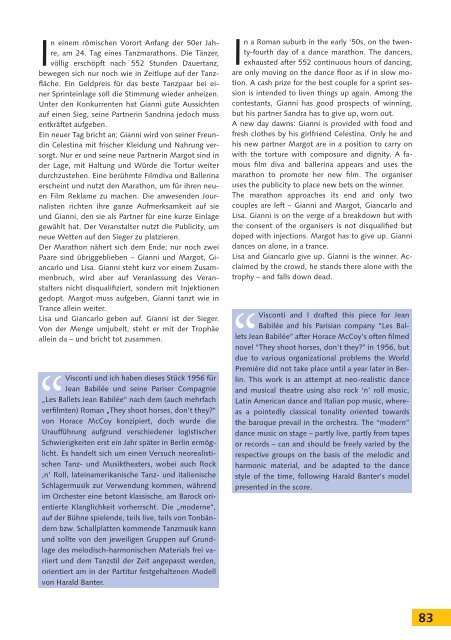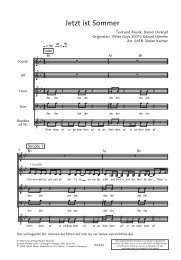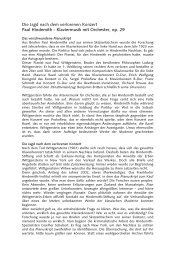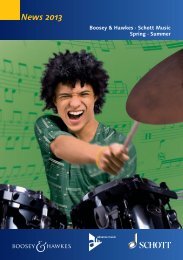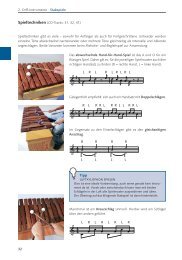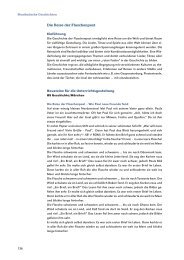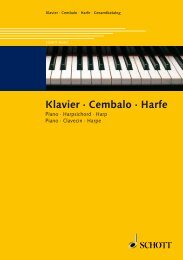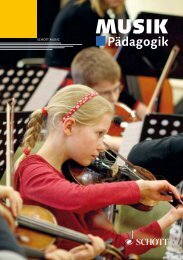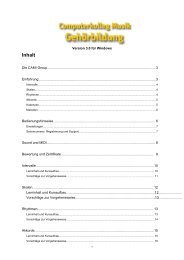HANS WERNER HENZE - Schott Music
HANS WERNER HENZE - Schott Music
HANS WERNER HENZE - Schott Music
Erfolgreiche ePaper selbst erstellen
Machen Sie aus Ihren PDF Publikationen ein blätterbares Flipbook mit unserer einzigartigen Google optimierten e-Paper Software.
I<br />
n einem römischen Vorort Anfang der 50er Jahre,<br />
am 24. Tag eines Tanzmarathons. Die Tänzer,<br />
völlig erschöpft nach 552 Stunden Dauertanz,<br />
bewegen sich nur noch wie in Zeitlupe auf der Tanzfläche.<br />
Ein Geldpreis für das beste Tanzpaar bei einer<br />
Sprinteinlage soll die Stimmung wieder anheizen.<br />
Unter den Konkurrenten hat Gianni gute Aussichten<br />
auf einen Sieg, seine Partnerin Sandrina jedoch muss<br />
entkräftet aufgeben.<br />
Ein neuer Tag bricht an; Gianni wird von seiner Freundin<br />
Celestina mit frischer Kleidung und Nahrung versorgt.<br />
Nur er und seine neue Partnerin Margot sind in<br />
der Lage, mit Haltung und Würde die Tortur weiter<br />
durchzustehen. Eine berühmte Filmdiva und Ballerina<br />
erscheint und nutzt den Marathon, um für ihren neuen<br />
Film Reklame zu machen. Die anwesenden Journalisten<br />
richten ihre ganze Aufmerksamkeit auf sie<br />
und Gianni, den sie als Partner für eine kurze Einlage<br />
gewählt hat. Der Veranstalter nutzt die Publicity, um<br />
neue Wetten auf den Sieger zu platzieren.<br />
Der Marathon nähert sich dem Ende; nur noch zwei<br />
Paare sind übriggeblieben – Gianni und Margot, Giancarlo<br />
und Lisa. Gianni steht kurz vor einem Zusammenbruch,<br />
wird aber auf Veranlassung des Veranstalters<br />
nicht disqualifiziert, sondern mit Injektionen<br />
gedopt. Margot muss aufgeben, Gianni tanzt wie in<br />
Trance allein weiter.<br />
Lisa und Giancarlo geben auf. Gianni ist der Sieger.<br />
Von der Menge umjubelt, steht er mit der Trophäe<br />
allein da – und bricht tot zusammen.<br />
“<br />
Visconti und ich haben dieses Stück 1956 für<br />
Jean Babilée und seine Pariser Compagnie<br />
„Les Ballets Jean Babilée“ nach dem (auch mehrfach<br />
verfilmten) Roman „They shoot horses, don’t they?“<br />
von Horace McCoy konzipiert, doch wurde die<br />
Uraufführung aufgrund verschiedener logistischer<br />
Schwierigkeiten erst ein Jahr später in Berlin ermöglicht.<br />
Es handelt sich um einen Versuch neorealistischen<br />
Tanz- und Musiktheaters, wobei auch Rock<br />
‚n’ Roll, lateinamerikanische Tanz- und italienische<br />
Schlagermusik zur Verwendung kommen, während<br />
im Orchester eine betont klassische, am Barock orientierte<br />
Klanglichkeit vorherrscht. Die „moderne“,<br />
auf der Bühne spielende, teils live, teils von Tonbändern<br />
bzw. Schallplatten kommende Tanzmusik kann<br />
und sollte von den jeweiligen Gruppen auf Grundlage<br />
des melodisch-harmonischen Materials frei variiert<br />
und dem Tanzstil der Zeit angepasst werden,<br />
orientiert am in der Partitur festgehaltenen Modell<br />
von Harald Banter.<br />
I<br />
n a Roman suburb in the early ‘50s, on the twenty-fourth<br />
day of a dance marathon. The dancers,<br />
exhausted after 552 continuous hours of dancing,<br />
are only moving on the dance floor as if in slow motion.<br />
A cash prize for the best couple for a sprint session<br />
is intended to liven things up again. Among the<br />
contestants, Gianni has good prospects of winning,<br />
but his partner Sandra has to give up, worn out.<br />
A new day dawns: Gianni is provided with food and<br />
fresh clothes by his girlfriend Celestina. Only he and<br />
his new partner Margot are in a position to carry on<br />
with the torture with composure and dignity. A famous<br />
film diva and ballerina appears and uses the<br />
marathon to promote her new film. The organiser<br />
uses the publicity to place new bets on the winner.<br />
The marathon approaches its end and only two<br />
couples are left – Gianni and Margot, Giancarlo and<br />
Lisa. Gianni is on the verge of a breakdown but with<br />
the consent of the organisers is not disqualified but<br />
doped with injections. Margot has to give up. Gianni<br />
dances on alone, in a trance.<br />
Lisa and Giancarlo give up. Gianni is the winner. Acclaimed<br />
by the crowd, he stands there alone with the<br />
trophy – and falls down dead.<br />
“<br />
Visconti and I drafted this piece for Jean<br />
Babilée and his Parisian company “Les Ballets<br />
Jean Babilée” after Horace McCoy’s often filmed<br />
novel “They shoot horses, don’t they?” in 1956, but<br />
due to various organizational problems the World<br />
Première did not take place until a year later in Berlin.<br />
This work is an attempt at neo-realistic dance<br />
and musical theatre using also rock ‘n’ roll music,<br />
Latin American dance and Italian pop music, whereas<br />
a pointedly classical tonality oriented towards<br />
the baroque prevail in the orchestra. The “modern”<br />
dance music on stage – partly live, partly from tapes<br />
or records – can and should be freely varied by the<br />
respective groups on the basis of the melodic and<br />
harmonic material, and be adapted to the dance<br />
style of the time, following Harald Banter’s model<br />
presented in the score.<br />
83


